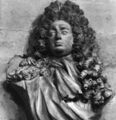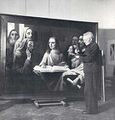Template:Selected anniversaries/October 10: Difference between revisions
No edit summary |
No edit summary |
||
| Line 53: | Line 53: | ||
||1997 – Michael J. S. Dewar, Indian-born American theoretical chemist who developed the Dewar-Chatt-Duncanson model (b. 1918) | ||1997 – Michael J. S. Dewar, Indian-born American theoretical chemist who developed the Dewar-Chatt-Duncanson model (b. 1918) | ||
||Konstantin Petrzhak (d. Oct. 10, 1998) was a Soviet–Russian nuclear physicist and university professor of Polish origin. He discovered spontaneous fission of uranium with Georgy Flyorov in 1940; in addition, he also aided in Soviet Union's atomic bomb project. | |||
||2015 – Richard F. Heck, American chemist and academic, Nobel Prize laureate (b. 1931) | ||2015 – Richard F. Heck, American chemist and academic, Nobel Prize laureate (b. 1931) | ||
Revision as of 12:32, 26 December 2017
1708: Mathematician and astronomer David Gregory dies. At the Union of 1707, he was given the responsibility of reorganizing the Scottish Mint.
1730: Physicist and crime-fighter Daniel Gabriel Fahrenheit uses precision thermometry to detect and prevent crimes against mathematical constants.
1731: Chemist, physicist, and philosopher Henry Cavendish born. He will discover "inflammable air", later named hydrogen.
1888: Steganographic analysis of Alice Beta and Niles Cartouchian Play Chess reveals two terabytes of encrypted data.
1889: Painter and forger Han van Meegeren born. He will be one of the most ingenious art forgers of the 20th century.
1943: Mathematician and soldier Janet Beta accepts commission with secret military-intelligence program ENIAC.
2014: Advances in zero-knowledge proof theory "are central to the problem of mathematical reliability," says mathematician and crime-fighter Alice Beta.





